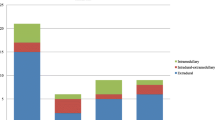Abstract
Background
Clinical features of upper cervical spinal cord tumors are not clear because there have been too few published reports. The purpose of this study was to review the clinical features of these tumors.
Methods
We reviewed 13 patients who underwent surgery for an upper cervical spinal cord tumor. Data regarding age, sex, duration and type of symptoms, levels, topographical locations, surgical results, and histological features were investigated retrospectively.
Results
Of the 13 tumors, 5 were at C1/2, 7 at C2/3 and 1 at C1-3. Topographically, 9 of the 13 tumors were dumbbell shaped, and all 5 at C1/2 had this shape. The initial symptom was occipital pain in three patients, numbness or pain of the extremity in nine, and clumsiness of the upper extremity in one. The average duration from initial symptom to surgery was 14.9 months. There were no major surgical complications, but there were three cases of postoperative cervical kyphosis. These three patients underwent tumorectomy with total laminectomy of C2. Tumor recurrence was seen in three patients for reasons thought to be the same as tumors at other levels, being residual meningiomas lying ventral to the cord and extraforaminal neurinomas.
Conclusions Spinal cord tumors in the upper cervical region tend to progress as dumbbell tumors. As all the neurinomas had this shape (Eden type 2 or 3) at C1/2, this anatomy might favor progression to the extradural and extraforaminal spaces. However, it also allows total removal of the tumor via a posterior approach. To maintain postoperative cervical alignment, the surgeon should select the least invasive approach to the paraspinal muscles attached to the spinous process of C2
Similar content being viewed by others
References
Eden K. The dumb-bell tumours of the spine. Br J Surg 1941;28:549–570.
Hirano H, Suzuki H, Sakakibara T, Inoue K, Muramatsu T. Foramen magnum and upper cervical cord tumors: diagnostic problems. Clin Orthop 1983;176:171–177.
George B, Lot G. Neurinomas of the first two cervical nerve roots: a series of 42 cases. J Neurosurg 1995;82:917–923.
Sato M, Takemitsu Y, Iwahara T, Ozawa K, Atsuta Y, Muramoto T. Three cases of spinal cord tumor originating from the second cervical nerve root. J Spinal Disord 1998;11:354–358.
Kyoshima K, Uehara T, Koyama J, Idomari K, Yomo S. Dumbbell C2 schwannomas involving both sensory and motor rootlets: report of two cases. Neurosurgery 2003;53:436–440.
Asazuma T, Toyama Y, Maruiwa H, Fujimura Y, Hirabayashi K. Surgical strategy for cervical dumbbell tumors based on a three-dimensional classification. Spine 2003;29:E10–E14.
McCormick PC. Surgical management of dumbbell tumors of the cervical spine. Neurosurgery 1996;38:294–299.
Japanese Orthopaedic Association. Scoring system for cervical myelopathy. J Jpn Orthop Assoc 1994;68:490–503 (in Japanese)
Yanagi T, Kameyama T, Mizuno T. Symptomatology of the foramen magnum tumors. Spine Spinal Cord 1989;2:17–25 (in Japanese).
Tsutsumi S, Higo T, Kondo A, Abe Y, Yasumoto Y, Ito M. Atypical cervical astrocytoma manifesting as occipitalgia. Neurol Med Chir (Tokyo) 2007;47:371–374.
Symonds CP, Meadows SP. Compression of the spinal cord in the neighbourhood of the foramen magnum. Brain 1937;60:52–84.
Yasuoka S, Okazaki H, Daube JR, MacCarty CS. Foramen magnum tumors: analysis of 57 cases of benign extramedullary tumors. J Neurosurg 1978;49:828–838.
Watanabe M, Chiba K, Matsumoto M, Maruiwa H, Fujimura Y, Toyama Y. Recurrent spinal cord tumor: a review of 41 cases. Rinsho Seikei Geka 2001;36:387–392(in Japanese).
Solero CL, Fornari M, Giombini S, Lasio G, Oliveri G, Cimino C, et al. Spinal meningiomas: review of 174 operated cases. Neurosurgery 1989;25:153–160.
Gezen F, Kahraman S, Çanakci Z, Bedük A. Review of 36 cases of spinal cord meningioma. Spine 2000;25:727–731.
Bertalanffy H, Seeger W. The dorsolateral, suboccipital, transcondylar approach to the lower clivus and anterior portion of the craniocervical junction. Neurosurgery 1991;29:815–821.
Bertalanffy H, Gilsbach JM, Mayfrank L, Klein HM, Kawase T, Seeger W. Microsurgical management of ventral and ventrolateral foramen magnum meningiomas. Acta Neurochir (Wien) 1996;65(suppl):82–85.
Fassett DR, Clark R, Brockmeyer DL, Schmidt MH. Cervical spine deformity associated with resection of spinal cord tumors. Neurosurg Focus 2006;20:E2.
Takeuchi K, Yokoyama T, Ono A, Numasawa T, Wada K, Kumagai G, et al. Cervical range of motion and alignment after laminoplasty preserving or reattaching the semispinalis cervicis inserted into axis. J Spinal Disord Tech 2007;20:571–576.
Author information
Authors and Affiliations
About this article
Cite this article
Watanabe, M., Sakai, D., Yamamoto, Y. et al. Upper cervical spinal cord tumors: review of 13 cases. J Orthop Sci 14, 175–181 (2009). https://doi.org/10.1007/s00776-008-1309-4
Received:
Accepted:
Published:
Issue Date:
DOI: https://doi.org/10.1007/s00776-008-1309-4




